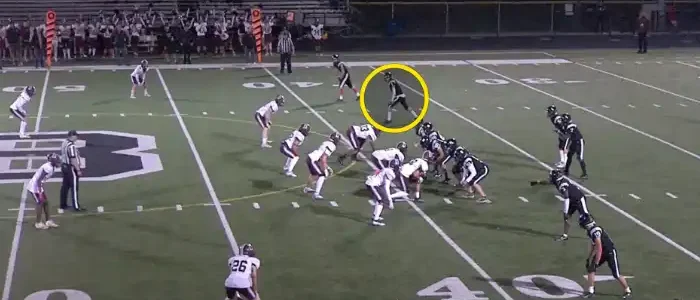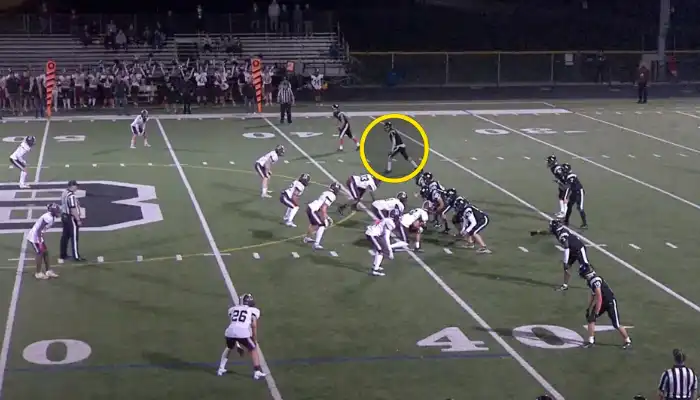
Every American football game is a symphony of athleticism and strategy. Positioned between the thunderous runs of the running back and the quarterback’s cannon arm, every position contributes pertinent notes to the overarching grand symphony of the game. But within this intricate ensemble, there is a player who usually goes unnoticed: the slot receiver.
The role played by the slot receiver in creating offensive opportunities is critical, as they operate in tight spaces between offensive linemen and wide receivers. For a clear understanding of what this entails, one must grasp their responsibilities and appreciate their skillset.

Decoding the Slot Receiver: Definition and Importance
The slot receiver is closer to the offensive line than traditional wideouts, typically lining up between the tackle and the outside receiver. Their main task is to receive passes in short to medium fields on field coverage. Nonetheless, their impact extends well beyond catching balls.
This includes:
- Matchup nightmares: Possessing flexibility that enables them to exploit weak links in defenses such as linebackers or smaller defensive backs.
- Reliable targets: Offering an option for quarterbacks when plays break down or during short-yardage situations.
- Versatility enhancers: By running multiple routes, it opens up all of its offense playbooks for other players leading defenses and adjusts coverage accordingly.
In summary, an attack uses a slot receiver as a pawn, among many others on its chessboard. Thus, when they are present, not only does an offense become productive, but it also creates space for other participants’ good performances by squeezing them out of such areas.
The Making of a Mastermind: Essential Traits of a Slot Receiver
While all football positions require athleticism, becoming an exceptional slot receiver demands a specific combination of physicality and mental ability. Here’s what it takes for a competent slot receiver:
Quickness and Agility
Unlike their outside counterparts, who rely on blazing speed, slot receivers need exceptional quickness and agility. They operate in tight spaces and need to change direction rapidly to get open against tight coverage.
Route Running Prowess
Route running is an art form in football, and the slot receiver elevates it to a whole new level. Their routes are often intricate and precise, requiring them to create separation from defenders who are just a few steps away.
Hands and Catch Radius
A solid pair of hands is crucial for any wide receiver, but for slots, it becomes a non-negotiable requirement. Usually, they make catches under duress; therefore, they must have quick “snatch” hands capable of plucking balls out of thin air with ease. Apart from that, having a broad catch radius sees them capitalize on slightly inaccurate throws, thus raising their overall statistics.
Toughness and Physicality
Playing in the slot means facing constant physical punishment from linebackers and safeties. Slot receivers need to be tough and physical to withstand the hits and maintain focus throughout the game.
Orchestrating Offense: The Role of the Slot Receiver in Action
The offensive scheme is complex and involves the slot receiver. Such a player contributes to the team’s success in certain important ways:
Creating Mismatches
Slot receivers are often physically big and skilled at what they do, which makes them create mismatches vis-à-vis defenders. With their size and quickness, they can beat slower linebackers or overpower smaller defensive backfields. Subsequently, this allows them to gain separation from defenders and become easy targets for quarterbacks.
Providing Reliable Targets
On occasions, such as third-down situations or short-range plays, the quarterback will look to his/her slot receiver to achieve the best possible result. In this way, they can be sure that every time the ball goes into their hands, it’s always a catchable one, thus enabling them to move chains and prolong drives.
Enhancing Versatility
The role of a slot receiver goes beyond just catching passes because of their ability to run with the ball. It is not unusual for them to act as blockers on rushing runs or even receive hand-offs directly from the line-of-scrimmage position, providing yet more dimensions within an offense’s playbook. Additionally, such unpredictability keeps defenses guessing about what players will move where on the field.
From the Outside In: Transitioning to the Slot Corner
While there is no separate position known as “slot corner,” it represents a specialized variant of the cornerback position in general rather than being an entirely different entity itself. The regularity of wide receivers staying on the sidelines means that traditionally, cornerbacks line up outside. As a result, slot corners are typically located in central areas near tight ends or directly opposite the slot receiver itself.
This change necessitates some slight adjustments to skill sets:
- Adaptability: To thrive at the cornerback position, one must have prior experience playing outside the box while taking on new roles as a slot corner. This means adapting to closer covers and more physical one-on-one situations at the line of scrimmage.
- Keen Eye for Detail: Slot corners have to be able to recognize offensive formations and pre-snap adjustments. They must anticipate route concepts and prepare for small slot receivers who thrive on swift, accurate routes.
- Physical Prowess: Though not a major concern regarding size, a slot corner will still require good strength and tackling abilities. In this position, one has many battles with slot receivers, who are highly skilled at creating separation within close coverage or running routes.
The Hallmarks of a Dominant Slot Corner
What separates a good slot corner from a great one? Let’s break down the essential qualities that define a defensive force working in the middle of the field:
- Coverage skills: This is what every cornerback knows best. Zone coverage requires a flawless technique for reading quarterbacks’ eyes, among other things, since it is such an important aspect for slot corners. On top of that, they should be able to play man-to-man defense against elusive slot receivers by staying tight all over them without giving away anything on their release off the line.
- Footwork and Agility: To be successful as a slot corner, players must possess tremendous quickness and agility. They have to change directions almost instantly, in addition to mimicking every cut or juke made by slot receivers in very short time durations. They must also maintain accurate footwork to maintain penalty-free tight coverage throughout the entire play.
- Awareness and Anticipation: Another prerequisite for success is a strong knowledge base and foresight into forthcoming happenings within game situations. Slot corners should look out for any blitz packages, screens, or trick plays coming towards them. The idea is that getting ahead of the quarterback’s passes not only helps in knocking them down but also alters the receiver’s patterns, thus making interceptions possible.
The Slot Corner’s Defensive Arsenal: More Than Just Coverage
A well-rounded slot corner offers more to the defensive scheme than just shutting down slot receivers.
- How to Neutralize Slot Receivers: The primary role of the well-rounded slot corner is to neutralize slot receivers so that they cannot catch passes and generate yards after the catch (YAC). This includes playing tight coverage, tackling effectively, and disrupting timing between a quarterback and a receiver.
- Support in Run Defense: These are not just pass-coverage specialists. Slot corners play a vital part in run defense by setting an edge on outside runs and flowing to the ball when plays develop inside the slot.
- Contributing to Blitz Packages: Slot corners can play a variety of roles during blitzes. They may choose to blitz themselves, thereby adding pressure on the quarterback, or drop into deeper coverage, accounting for potential hot routes out of the backfield.
The Chess Match: Slot Corner vs. Slot Receiver
The slot corner versus slot receiver battle is an interesting chess match in football. Each player employs specific strategies and tactics against one another:
- Decoding Routes — Slot corners utilize pre-snap reads to decode the receiver’s intentions. These players analyze offensive formations, receiver splits, and tendencies to predict route concepts.
- Countering Strategies — To create separation, slot receivers have different methods. They exploit holes in coverage using slants, curls, quick outs, or may even employ screens and rub routes emerging from tight coverage situations.
- A Constant Struggle —The strategic battle between slot corners and slot receivers persists throughout the game. As I said, Nickelback will have to adjust their coverage accordingly, depending on what the receiver does. However, it’s not only up to the defenders; wideouts also have the flexibility to change their routes. Despite having a well-thought-out plan in place by the secondary defenders, this is a game that is often characterized by an unpredictable nature, leading to adjustments as events unfold. It is an ongoing argument, with both sides trying to maintain each other’s patience.
Impact on Game Dynamics: The success of slot corners determines how games flow directly. An efficient slot corner can shut down a team’s slot receiver, forcing them to rely on outside throws or even make changes to their offensive plans altogether. If the quarterback’s rhythm changes, it is easy for the defense to create turnovers and stop scoring drives, making it harder for him to get into one because he will be under more pressure, including this.
Conclusion
Finally, both slot receivers and slot corners are often overlooked heroes of American football. Whether it is agility by slot receivers maneuvering through tight spaces or anticipation by slot corners guarding against elusive wideouts, such players significantly determine the outcome of games. Their strategic duels within an arena-like play field reminiscent of a chess board, underscore how complex this game could get. Knowing what they mean adds more depth to our understanding of football and what it takes to specialize in those positions.

